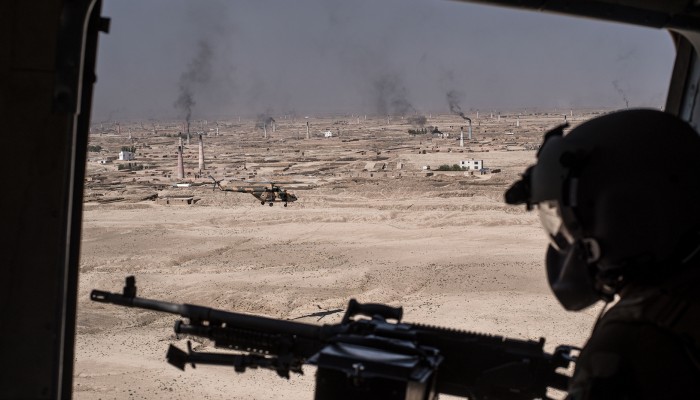This piece is adapted from remarks presented at a symposium sponsored by the Legislative Branch Capacity Working Group (a joint project of R Street Institute and New America) held at the Capitol Visitor Center in Washington on November 12, 2019.
When it comes to Congress’s role in initiating military conflict, there’s a growing gap between what’s specified in the Constitution and what we’re seeing in practice.
As we all know, the Constitution gives Congress the power to declare war. The founders assigned this role to Congress because they wanted to make it hard to get into wars. As James Madison wrote, “The constitution supposes, what the History of all Governments demonstrates, that the Executive is the branch of power most interested in war, and most prone to it. It has accordingly with studied care, vested the question of war in the Legislature.”
An earlier draft had given Congress the power to “make war.” The ratification history clearly indicates two reasons why “make war” was replaced with “declare war.” First, the change was meant to preserve the president’s ability to “repel sudden attacks” without advance congressional authorization. Second, it would ensure that Congress did not micromanage the actual conduct of the war, which was entrusted to the president as Commander in Chief of the armed forces.
Formal declarations of war proved to be quite rare. But up until the mid-20th century, military engagements generally were conducted pursuant to statutory authorization short of a formal declaration, a practice the Supreme Court upheld in 1800. That was the norm until President Truman sent American forces into Korea.
Since that time, we’ve seen an increasing pattern of presidents initiating military action overseas without congressional authorization. Modern examples (post-Vietnam) include:
- President Reagan’s strikes against Libya after the Beirut bombing
- President George H.W. Bush’s intervention in Panama and introduction of U.S. troops into Somalia
- Multiple military deployments by President Bill Clinton, including actions in Bosnia, Haiti, Kosovo, Sudan, and Afghanistan
- President George W. Bush’s intervention in Haiti
- President Obama’s airstrikes in Libya and in Yemen
- President Trump’s airstrikes in Syria
To a shocking degree, the justification for this pattern has rested on pure bootstrapping. In OLC opinion after OLC opinion, the executive branch has argued that it has the constitutional authority to initiate armed conflict without congressional approval because it has repeatedly done so, and because Congress has acquiesced. As a result, what was initially understood as a narrow Article II authority to “repel sudden attacks” has been recharacterized as a sweeping authority to engage in military operations to defend “important national interests,” as long as those operations fall short of full-fledged “war.”
A theoretical constraint on this authority is the War Powers Resolution of 1973, or WPR. Under the WPR, the president must report to Congress within 48 hours of introducing armed forces into hostilities or situations where hostilities might be imminent. Within 60 days of the deadline for reporting, or 90 days if extended by the president, the president must end the military action unless Congress has authorized it. Congress also can require the president to withdraw armed forces by passing a concurrent resolution, or a so-called legislative veto, which takes effect without the president’s signature.
The WPR hasn’t worked, for several reasons. First, instead of reading the 60-to-90-day limitation as a backstop to enforce constitutional limitations, presidents have read it as acknowledging the president’s authority to conduct military operations without congressional approval for a period of 60 to 90 days.
Second, presidents have routinely evaded the reporting requirement by interpreting the term “hostilities” to exclude most of the techniques and practices that characterize modern warfare. Once again, Congress has almost completely acquiesced, making no effort either to authorize or to prohibit military actions begun by presidents without the required reporting.
Finally, in 1983, the Supreme Court held that a legislative veto provision in a different law was unconstitutional. While it’s not a certainty that the WPR’s concurrent resolution provision would meet the same fate, it’s quite possible that Congress would need to pass a joint resolution instead, which would effectively require a veto-proof supermajority.
Up to now, I’ve been talking about the problem of presidential war-making without advance congressional authorization. But another trend in modern history is presidents exceeding the scope of congressional authorizations when Congress does provide them. A living example is the 2001 Authorization for Use of Military Force.
The 2001 AUMF authorized the use of military force against “those nations, organizations, or persons who [the president] determines planned, authorized, committed, or aided the terrorist attacks that occurred on September 11, 2001, or harbored such organizations or persons.” Eighteen years later, this law has been invoked 37 times to support conflicts occurring in 14 different countries, against organizations that did not even exist on 9/11. Three successive administrations have accomplished this feat by interpreting the 2001 AUMF to apply, not only to the enemies specified, but to any “associated forces,” a term that the executive branch has stretched beyond any commonsense meaning.
The obvious solution for such overreach is for Congress to repeal or clarify the authorization or refuse to fund the extraneous military activities. Instead, a bill introduced by Senators Bob Corker and Tim Kaine in 2018 would have given congressional blessing to presidential war-making by adopting the executive branch’s definition of “associated forces” and authorizing the president to determine who qualifies. In other words, the bill would have provided authority to the president to use military force against enemies of his choosing. That would delegate away the most central aspect of Congress’s war-making authority: the designation of the enemy.
Why does any of this matter? Recall that a main purpose of giving Congress the power to declare war was to keep us out of wars. We have now been at war for 18 years, the longest in our country’s history. Today, soldiers are being deployed to fight in a war that started before they were born. We have spent over 6 trillion dollars on the conflict. More than 6,000 American soldiers have lost their lives, with nearly 50,000 injured. By conservative estimates, 30,000 civilians have been killed in Afghanistan. This is exactly what the founders sought to avoid.
There are signs that Congress is interested in taking back some of the power it has given away in the area of war powers and in related areas of foreign relations and national security. In April, Congress voted to end U.S. military activities in Yemen. In July, Congress passed three resolutions to block arms sales to Saudi Arabia and the United Arab Emirates. In March and again in September, Congress voted to terminate the national emergency President Trump declared to divert funding to his border wall.
Thus far, these efforts have failed because Congress cannot muster the necessary supermajority to override the president’s veto. The lesson is clear: once Congress gives away its power, it is exceedingly difficult to take it back.



